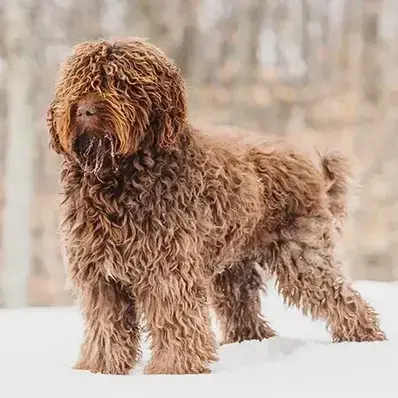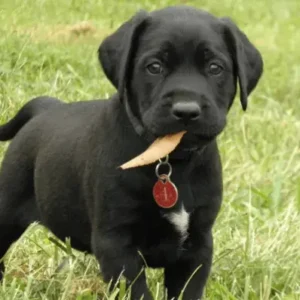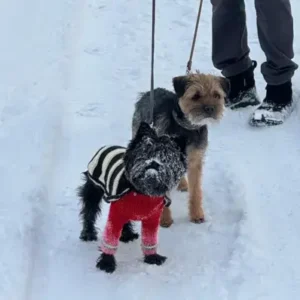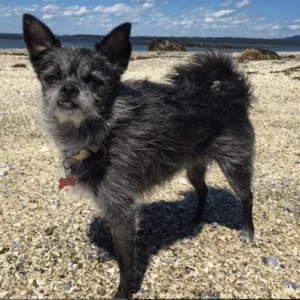Barbet History/Origin
The Barbet, also known as the French Water Dog, hails from France and has a long history as a water dog, helping hunters retrieve water games. Records dating back to the 16th century mention this breed’s skills. Despite its usefulness, the Barbet faced tough times after the World Wars, and its numbers dropped dangerously low.
Fortunately, a small group of dedicated fans refused to let the Barbet fade away. Their hard work paid off, and the breed was saved from extinction. Even though Barbets are still a relatively rare breed, people all over the world adore them for their loving nature.
Barbet history- Source: AKC.org
In 1995, the United Kennel Club officially recognized the Barbet, giving it some well-deserved recognition. Then, in 2020, the American Kennel Club (AKC) followed suit, acknowledging the Barbet’s importance under Sporting Group.
Throughout the centuries, the Barbet earned its place as a favored companion among French nobility and aristocracy. The Barbet was renowned for loyalty and versatility. It excelled in hunting and was cherished as a household companion and guardian.
Barbet Personality
Barbets are known for their friendly and outgoing nature. They are highly sociable dogs that thrive on human companionship and make excellent family pets.
Their playful demeanor and intelligence make them great companions for children and adults alike. These dogs love to engage in interactive games and are always up for some fun.
As water dogs, they have a natural affinity for the water and enjoy participating in water sports such as swimming.
- Temperament
Barbets have a warm and affectionate temperament, making them a joy to be around. They are happiest when they are part of the family and love to spend time with their owners.
Barbets are intelligent dogs. As working dogs, they might need continuous obedience training to adapt to different environments. Overall, Barbets are intelligent, affectionate, and energetic companions who bring endless joy and laughter to their families.
Barbet Physical Appearance
Barbets have a charming and distinctive appearance with lush, curly coats and expressive eyes. Their bodies are strong and well-proportioned.
They have long, flat, and broad ears covered with their wavy hanging hair. Their necks are short and strong, while their broad, well-developed chests give them a powerful stance.
- Size
Barbets are medium-sized dogs known for their sturdy build. Typically, they stand between 22 to 25.5 inches tall. In terms of weight, Barbets typically weigh between 37 to 62 pounds for males and 33 to 55 pounds for females.
- Coat Color and Texture
These purebred dogs come in various solid colors or combinations, including solid black, grey, brown, fawn, pale fawn, white, or more or less pied.
Additionally, they may display shades or hues of red fawn and pale fawn. Typically, the whole body is the same uniform shade.
Their coat is a distinctive feature, characterized by its long, woolly, wavy, and curly texture, covering the entire body in its natural state.
Solid black Barbet – Source: bobbi_de_barbet
Brown Barbet – Source: charliethebarbetdog
White Barbet with black markings – Source: teppo_and_osku_barbets
Grey Barbet – Source: teppo_and_osku_barbets
Fawn Barbet – Source: tarathebarbet
Barbet Gender Differences
In terms of size, males typically tend to be bigger and more muscular compared to females. On average, male Barbets have a height range of 22 to 25.5 inches, while females stand between 20 to 24 inches tall.
When it comes to temperament, there can be some differences between male and female Barbets.
Males may exhibit more dominant behaviors, especially after breeding, and may become aggressive with any fellow male Barbet pets.
On the other hand, females may display a slightly more stubborn demeanor, and their character may fluctuate depending on their hormonal cycles.
It’s essential to consider these differences when choosing the right companion for your lifestyle and household dynamics.
Barbet Feed/Nutrition
Barbets have moderate energy levels and require a balanced diet to maintain their health.
High-quality dog food supplemented with occasional treats is essential to meet their nutritional needs. This usually consists of a blend of premium protein, essential fats, vitamins, minerals, and fiber sourced from vegetables such as broccoli and berries such as blueberries. Ensure fresh water is always available, and consult with a veterinarian to tailor a feeding plan specific to your Barbet’s needs.
Barbet Health
Barbets, like many dog breeds, are prone to certain health conditions. Owners need to be aware of these potential issues and take proactive steps to monitor their pet’s health.
- Progressive Retinal Atrophy: Progressive retinal atrophy is a genetic condition that affects the retina of the eye, leading to gradual vision loss and eventual blindness. Symptoms typically begin with night blindness and progress to daytime vision impairment.
- Hip Dysplasia: Hip dysplasia is a common orthopedic condition in dogs, characterized by abnormal development of the hip joint. This can lead to pain, stiffness, and difficulty in movement. While genetics play a significant role in hip dysplasia, factors such as diet, exercise, and weight management also contribute to its development.
- Cataracts: Cataracts are a clouding of the lens of the eye, leading to decreased vision or blindness if left untreated. While cataracts can develop due to aging, they can also occur in younger dogs due to genetics or underlying health conditions.
Barbet Care and Grooming
Barbets have a thick and wavy coat, with an outer layer of wiry hair that requires regular grooming with brush and comb. Due to their coat type, they are considered high maintenance in terms of grooming.
Daily brushing is essential to keep their coat tangle-free, and a wide-toothed comb is used to untangle any knots before using a brush. While they do not shed like other breeds, their hair may come out in tufts, making it easier to manage during grooming sessions.
Regular trimming is necessary as their coat grows quickly to maintain its desired length and shape. However, Barbets only need to be bathed when necessary, and their coat should be air-dried to preserve their natural curly texture.
Maintaining good oral hygiene is crucial for your Barbet’s overall health. Brush your dog’s teeth daily with a dog-specific toothbrush and toothpaste to prevent tartar buildup, gum disease, and bad breath. Provide dental chews or toys to help keep their teeth clean between brushings. Additionally, focus on house training your dog to ensure they develop good habits and maintain a clean living environment.
Barbet Rescue Groups
For those interested in adopting a Barbet, there are several rescue organizations dedicated to finding loving homes for these wonderful dogs.
Barbet Price
The price of a Barbet usually ranges from $1,500 to $3,000, depending on factors such as breeder reputation and pedigree.
Interested in adding a Barbet to your family? Be sure to research reputable breeders who prioritize the health and well-being of their dogs.
Interesting Facts
- The Barbet breed has left its mark on the French language, with its name derived from the French word “barbe,” meaning beard. Additionally, the phrase “Être crotté comme un Barbet” has become popular, politely translating to being very muddy due to the breed’s tendency to play in muddy waters.
- First mentioned in historical records dating back to 1387, Barbets gained popularity over the centuries. Notably, King Henry IV of France was a notable admirer of the breed, further elevating its status.
- The Barbet is an ancient breed with historical ties to various other breeds, including the Poodle, Bichon, Griffon, Otterhound, Newfoundland, and Briard. This rich lineage contributes to the breed’s unique characteristics and versatility.
- Barbet appeared in the breed judging show in 2023.
Best For
Barbets are well-suited for families, active individuals, and those who enjoy outdoor activities, especially water-related sports.
Top Names
| Male Barbet Names | Female Barbet Names |
| Leo | Rosie |
| Oscar | Luna |
| Finn | Willow |
| Baxter | Ruby |
| Milo | Stella |









 Barbet history- Source:
Barbet history- Source: 

 Solid black Barbet – Source:
Solid black Barbet – Source:  Brown Barbet – Source:
Brown Barbet – Source:  White Barbet with black markings – Source:
White Barbet with black markings – Source:  Grey Barbet – Source:
Grey Barbet – Source:  Fawn Barbet – Source:
Fawn Barbet – Source: 







